Ever wonder how some companies seem to have it all together while others spin their wheels in chaos? The secret often lies in their organizational structure.
Just like an architect designs a building's blueprint, a company's leadership must construct the perfect framework for their business.
But unlike buildings that stand still, companies are living, breathing organisms that must adapt over time.
Today we'll peek behind the curtains of high-performing organizations to reveal the structural magic that makes them tick.
Together we'll explore different types of organizational structures to see which one suits best for you.
Overview
| Which is the most commonly used organizational structure? | Hierarchical structure |
| What is the most challenging type of organizational structure? | Matrix structure |
| What type of structure would you likely choose if your firm's environment is stable? | Functional structure |
Table of Contents
- What is an Organizational Structure?
- Types of Organizational Structures
- Key Takeaways
- Frequently Asked Questions

Looking for More Fun During Gatherings?
Gather your team members by a fun quiz on AhaSlides. Sign up to take free quiz from AhaSlides template library!
🚀 Grab Free Quiz☁️
What is an Organizational Structure?

An organizational structure refers to the formal system of task and reporting relationships that control, coordinate, and motivate workers to work together to achieve organizational goals. The key elements that define an organizational structure include:
- Division of Labor - The splitting of work activities into specific jobs or tasks to be performed. This involves specialization and departmentalization.
- Departmentalization - Grouping jobs into departments based on their common function (e.g. marketing department) or customer/target group served (e.g. business development department).
- Chain of Command - The lines of authority that specify who reports to whom and reflects the hierarchy in the organization. It shows the hierarchy and levels of management.
- Span of Control - The number of direct subordinates a manager can effectively oversee. A wider span means fewer layers of management.
- Centralization vs Decentralization - Refers to where decision-making authority lies within the organization. Centralized structures have power concentrated at the top, while decentralized structures distribute authority.
- Formalization - The extent to which rules, procedures, instructions, and communication are written. Higher formalization means more rules and standards.
The organizational structure determines how all these elements are put together to optimize performance and achieve the company's goals. The right types of organizational structure depend on factors like size, strategy, industry, and leadership style.
Types of Organizational Structures
What are the types of organizational structures?
There are generally 7 types of organizational structures in the business world. Among these different organizational structures, some structures focus power at the top, while others distribute it throughout the ranks. Certain setups prioritize flexibility, while others optimize control. Let's explore what organizational structure types in business are:
#1. Team-based organizational structure
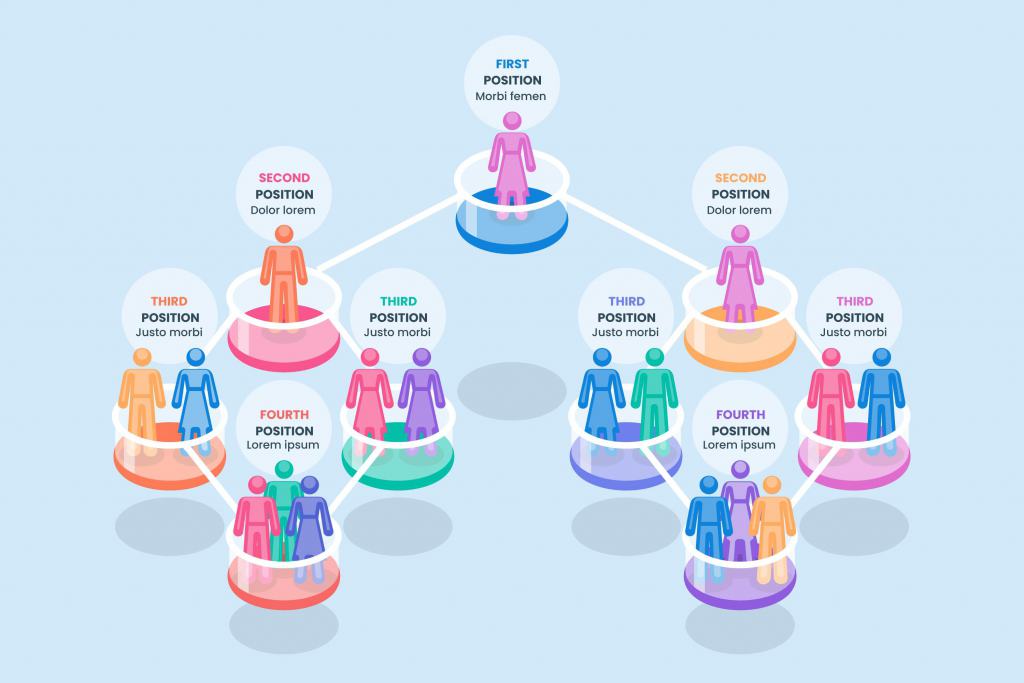
A team-based organizational structure is one where work is primarily organized around teams rather than individual job roles or traditional departments.
Teams are formed bringing together employees from different functional areas or departments to work on a particular project or goal. They focus on shared objectives and outcomes rather than individual targets. Success or failure is a collaborative effort. This breaks down silos.
They're self-managed, meaning they have a high degree of autonomy and are empowered to manage their own work processes with little oversight from managers. Teams have responsibilities like scheduling, assignments, budgeting, processes, and resources without needing approvals from the higher-ups.
There is less vertical hierarchy and more horizontal coordination and communication between teams. Team-based organizational structures have numerous opportunities for members to interact and collaborate so that they can enhance their teamwork skills.
Team memberships may change as projects and priorities change. Employees can be part of multiple teams simultaneously.
#2. Network structure

A network structure in organizational design refers to a model that is based on flexible, project-based teams rather than fixed departments or job roles.
Teams are formed on a project-by-project basis bringing together different skills and roles as needed. Teams dissolve after projects end.
There are no strict managers, rather multiple team leaders share responsibilities. Authority is distributed based on roles and domains of expertise.
Information flows laterally through interconnected teams rather than a top-down hierarchy.
Job roles are dynamic and defined based on skills/knowledge contributions rather than fixed job titles.
The organizational design can flexibly change based on evolving strategies and projects without being constrained by rigid roles. Individual contributions are evaluated based on collaborative success rather than individual performance metrics.
#3. Hierarchical structure
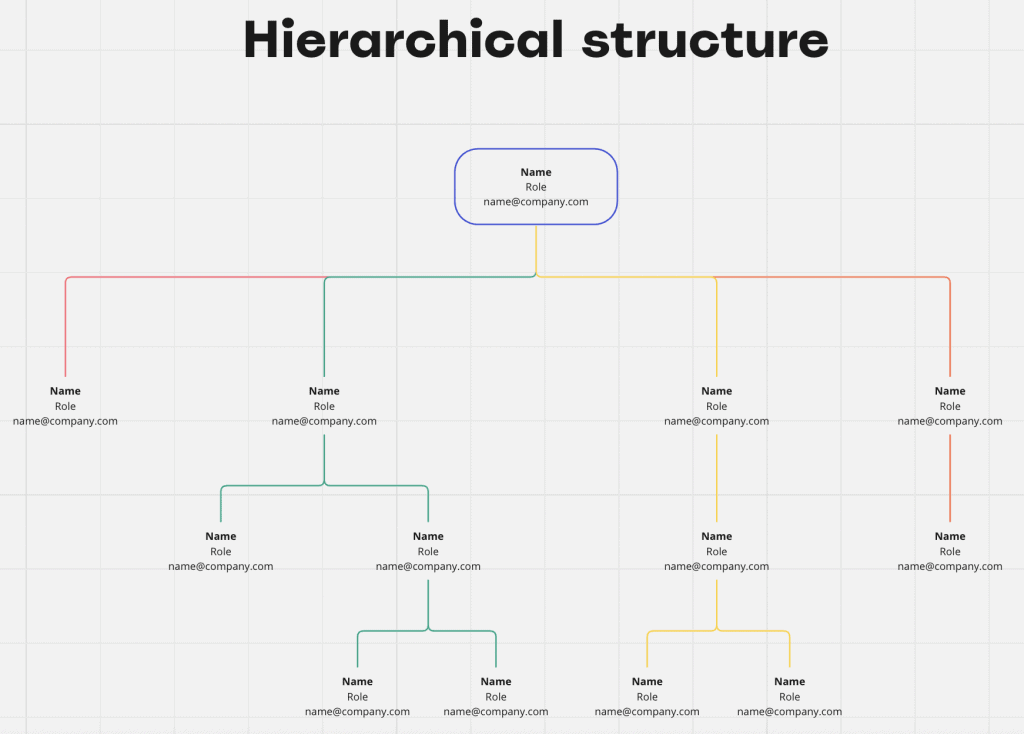
Being one of the basic organizational structures, a hierarchical organizational structure is a traditional top-down structure where authority flows from top-level management down through various levels of middle and lower management to the front-line employees.
There are usually multiple levels of managers and sub-managers between senior leadership and front-line staff.
Strategic decisions are made at the top levels with less autonomy lower down.
Work is subdivided into specialized operational tasks and departments with limited flexibility but shows a clear path for promotion in the ladder.
Communication predominantly flows from top to bottom through the layers of management.
This structure works well for stable, mechanical tasks in predictive environments that don't require flexibility.
#4. Matrix organizational structure
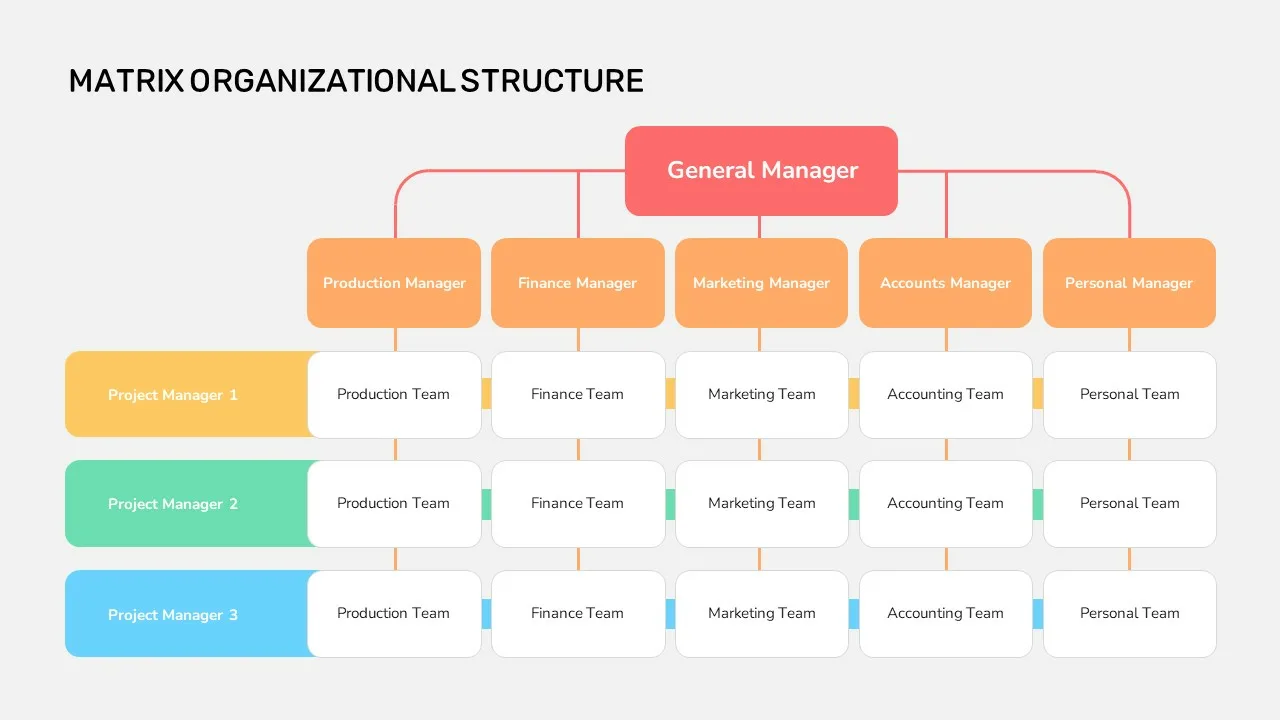
A matrix setup is like having two bosses at the same time. Instead of just reporting to one manager in your department, people report both to their functional lead and a project manager.
The company pulls people from different teams together for specific projects. So you might have engineers, marketers, and salespeople all working on the same project team for a bit.
While they're working as a project squad, those individuals still have the responsibility to their regular department, so the marketer is answering to the marketing VP but also the project director.
This can cause some issues since you might get confused over tasks and witness conflict between the department manager and the project manager.
It does allow companies to pull together all the experts needed for projects. And people get experience in both their specialized work and broader projects.
#5. Horizontal/Flat organizational structure

A horizontal or flat organizational structure is one where there aren't too many levels of management between the top management and the frontline workers. It spreads things out more laterally instead of having a big tall hierarchy.
In a flat structure, information tends to flow around more freely without having to go up and down a long chain of command. Communication is more fluid between different teams too.
Decision-making is less centralized at the top. The leadership team tries to empower individual contributors and give them ownership over their work.
Employees may self-manage more and have a broader scope of duties rather than very narrow specialized roles.
With fewer management layers, overhead costs are reduced. And response time usually improves since requests don't need multiple stamp approvals up and down a big chain. This is fitting for early-stage start-ups and small companies, where decisions need to be made fast.
#6. Functional organizational structure
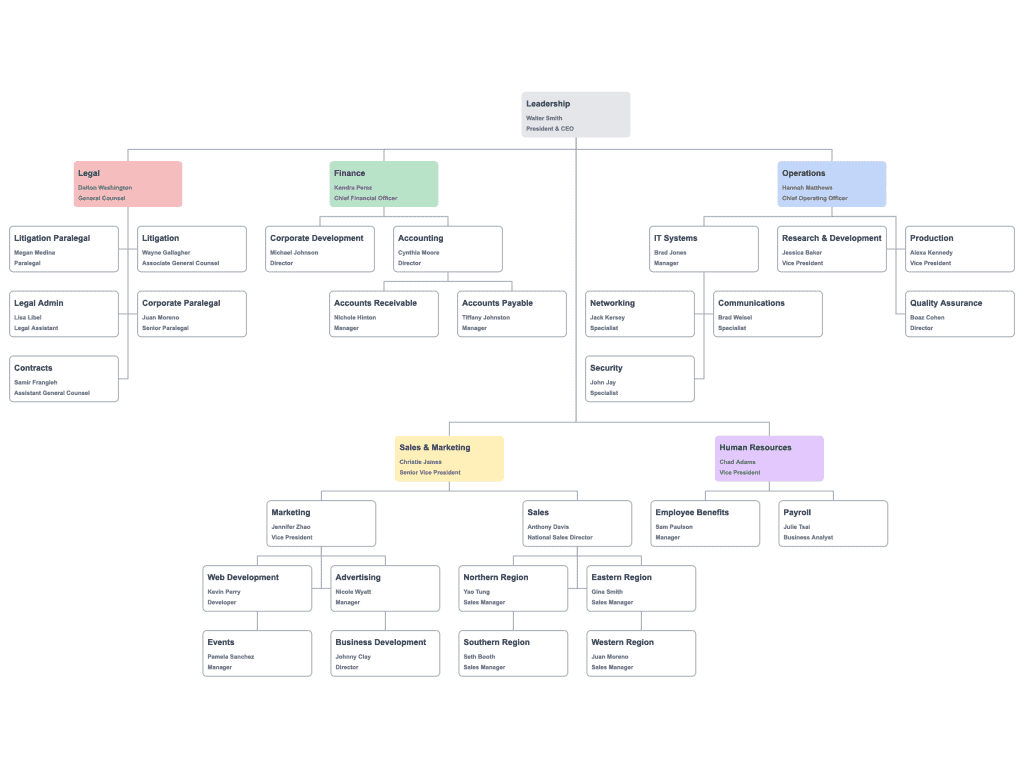
In a functional organizational structure, the work in a company gets grouped based on expertise or specialty. In other words, it's organized around business functions.
Some common functional departments include:
- Marketing - handles advertising, branding, campaigns, etc.
- Operations - oversees production, supply chain, fulfillment, etc.
- Finance - takes care of accounting, budgeting, and investments.
- HR - recruits and manages people.
- IT - maintains tech infrastructure and systems.
In this setup, people working in the same discipline - say marketing - are all bundled together in the same department. Their boss would be the VP or director of that specific function.
Teams focus inwardly on optimizing their specialty, while coordination across functions needs its own effort. Like marketing creates campaigns, operations prints brochures, and such.
It helps develop deep expertise when the employees are surrounded by others in their field. And it provides clear career paths within functions.
However, it can be tougher to collaborate as people are divided by silos. And customers see the company through a functional rather than holistic lens.
#7. Divisional structure
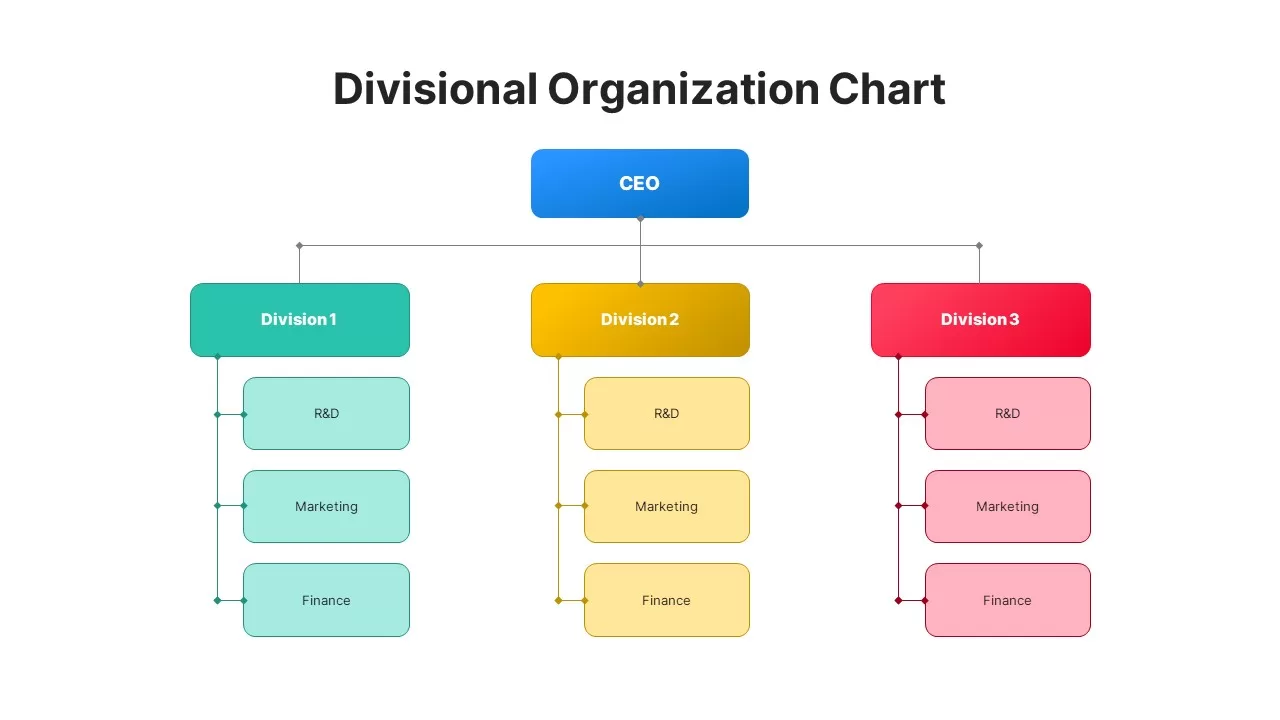
The divisional organizational structure definition seems pretty easy to understand. With a divisional setup, the company basically splits itself up into separate sections based on the different types of products it makes or the geography it serves. It works well for diversified companies operating in different industries or places.
Each section acts pretty independently, almost like its own mini-company. It’s got all its own people and resources to handle stuff like marketing, sales, manufacturing - whatever it needs just for that one piece of the business.
The leaders of these individual sections then report to the main CEO. But otherwise, the divisions call most of their own shots and aim to turn a profit on their own.
This structure lets each section really focus and tailor itself to the specific market or customers it’s dealing with. Rather than a one-size-fits-all approach for the whole company.
The downside is coordinating everything takes work. The divisions might start doing their own thing without synergy. But if managed right, it empowers businesses dealing in multiple industries or areas.
Key Takeaways
Most companies incorporate elements of different structures based on their goals, size, and industry dynamics. The right blend depends on a firm's strategy and operating environment, but these 7 different types of organizational structures encompass the fundamental structural frameworks used across organizations globally.
Frequently Asked Questions
What are the 4 types of organizational structures?
The four main types of organizational structures are Functional Structure, Divisional Structure, Matrix Structure, and Network Structure.
What are the 5 types of organizations?
There are 5 types of organizations Functional Structure, Projectized Structure, Network Structure, Matrix Structure, and Divisional Structure.







